In the skin of the chameleon he finds a close net-work of minute ducts, connecting with pigment-vesicles situated on its under surface. When the coloring-liquid is all retained in these vesicles, the animal's skin appears yellowish, that being the color of the semi-transparent epidermis. When the liquid is injected into the ducts, the color of the animal changes, the tint depending on the degree of tension in the ducts. If a nerve be cut, the region of the chameleon's body to which that nerve was distributed becomes at once a deep black, and no more color-changes occur over that area. If a piece of the skin be placed under a microscope, it will appear black. Pass a current of electricity through it, and there will be seen white vacuoles, which coalesce into irregularly-shaped masses, and these in turn break up into minute vacuoles again, leaving the field of a greenish color. Stop the current, and the reverse order of phenomena appears. M. Bert finds that the effect of curare on the chameleon is to give it a very dark color, while chloroform, on the contrary, lightens the tint; but when given in quantity sufficient to destroy the animal's life, chloroform darkens the color. Bert is disposed to believe that the chameleon possesses a special set of "color-nerves" distinct from the motor and sensory systems, and that these nerves are under the control of the will.
| THE ENGLISH OBSERVATORIES. |
TRANSLATED FROM THE FRENCH, BY EMMA M. CONVERSE.
THE English Astronomer Royal has in his possession a very curious collection of papers, including letters that have been addressed to him by persons of every condition, in which they ask his price for casting a horoscope. In spite of such simplicity, England is one of the countries where the taste for practical astronomy is very widely diffused, and also the one where the greatest number of public and private observatories is found. Establishments of the last category abound in the United Kingdom, and attest by their number and importance the popularity of the most sublime of the sciences. There are at the present time forty observatories in the British Isles, and fifteen in the English colonies; this is a quarter of the total number that is found in the whole globe, for there are in Europe something like a hundred and twenty establishments meriting this name, and about two hundred in the entire world.
The Royal Observatory of Greenwich takes the lead, for its past labors as well as for its present position, over the other establishments of the same kind possessed by the English. It was founded in 1675, three years after the Observatory of Paris. Charles II. chose a locality for the edifice on a hill commanding the Thames and the passage
